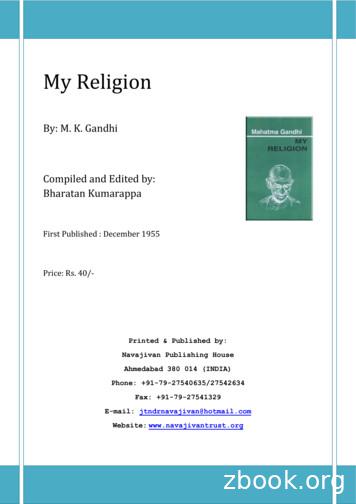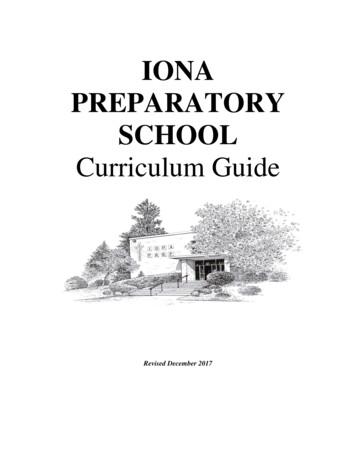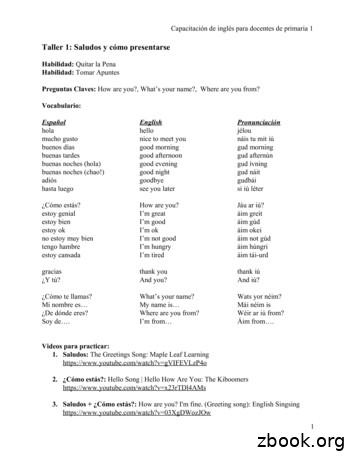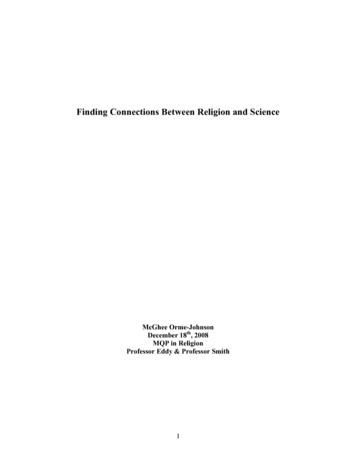Religion In Good Omens - Skemman.is
HugvísindasviðReligion in Good OmensA Study of the Usage and Effect of Religion in theComedic Fantasy Novel Good OmensRitgerð til BA-prófs í EnskuErla Filipía HaraldsdóttirJanúar 2014
Háskóli ÍslandsHugvísindasviðEnskaReligion in Good OmensA Study of the Usage and Effect of Religion in theComedic Fantasy Novel Good OmensRitgerð til BA-prófs í EnskuErla Filipía HaraldsdóttirKt.: 281090-2679Leiðbeinandi: Úlfhildur DagsdóttirJanúar 20142
AbstractWhen analysing the fantasy novel Good Omens (1990) by Terry Pratchett andNeil Gaiman, one comes across various interesting features, most to do with itsrelationship with the source material, the Bible. As it is a fantasy novel, theauthors have defined the Christian biblical elements as foreign and 'other',outside of the realm that is familiar and natural to the reader, and can therebyrender both Heaven and Hell antagonistic. An important element of that is themorality of the central characters. Those of them that are human have free will,and are therefore in control of their own destiny and consequently can takeresponsibility for their actions. Thus the humans are moral creatures. On theother hand, the characters that belong to either the forces of Heaven or Hell,that is, angels or demons, have no free will, and are completely under thecontrol of either God or Satan. Therefore Heaven and Hell are exempt frommoral consequences. They have no free will, are not to blame for their actions,and therefore their actions can not be classified as morally good or bad.Furthermore, the story takes place in the last eleven years before theapocalypse, as told in Revelation, and therefore a number of biblical charactersare included, such as The Four Horsemen of the Apocalypse. BesidesRevelation, Good Omens pays homage to two other chapters from the Bible,these being Genesis and the Gospels. This essay attempts to examine theinfluences of these biblical passages and look at their effects in correlation withthe novel's themes.
Table of ContentsAbstract . 31 Introduction . 52 About Good Omens . 73 Theory . 94 Theology . 134.1 Bible. 134.2 Genesis. 134.2.1 Adam Young . 144.3 Revelation . 164.3.1 Riders of the Apocalypse . 174.3.2 Them . 204.4 New Testament . 214.4.1 Agnes Nutter . 214.4.2 Adam Young . 224.5 Angels and Demons . 245 Philosophy. 265.1 Free Will . 265.2 Morality . 306 Conclusion . 37Works Cited . 384
1 IntroductionIn early works of literature, in the period ranging from ancient times until theMiddle Ages, religion and real life were hardly distinguishable. This was partlybecause of the immense integration of the two in everyday life, but alsobecause there was no common world view that didn't feature the presence of adeity of some sort. As different world views became increasingly widespread,and as science began to undermine the dependence people had on biblical andtheological explanations of life's mysteries, these elements began to disappearfrom realist fiction. They were later relegated to the side-lines of literature, alongwith myths, fairy tales and folklore. In an increasingly secularized society,religious novels concerning matters of faith directly seem to have fallen out offavour, having been replaced by literature featuring more subtle references toreligion. One example of such a 20th century novel with religious undertones isC.S. Lewis' Chronicles of Narnia series (1950-1956), which relies heavily onChristian symbolism and biblical connotations. In recent times, novels featuringdirect references to events from the Bible seem to have mostly beenapocalyptic, since, in the Christian world view, the only biblical event yet to takeplace is that of the end of the world. This is where Good Omens (1990) by TerryPratchett and Neil Gaiman comes in. While it belongs to the latter group ofnovels, pertaining directly to the apocalypse as described in Revelation, itenters this religious dialogue from a slightly different angle than has previouslybeen employed. Using humour to convey significant messages about the natureof creation, Good Omens manages to divert the attention away from the biblicalevent of the apocalypse itself. Instead it is focused on the consequences and5
the catalyst of the apocalypse, shedding light on the functions of Heaven andHell, and their ultimate intent. At the same time, the unfolding events deviatefrom the ones described in the Bible, in concordance with the changedperspective. Thus the traditional paradigm of good versus evil, Heaven versusHell, falls into the background as humanity enters the debate, and in the enddefeats both sides' combined efforts to initiate the apocalypse. This essay aimsto explore this change as well as the usage of biblical references and Christiansymbolism in Good Omens to better understand the narrative and the deeperethical questions that the novel evokes, as it separates the ideas of Heaven'sgoodness and Hell's evil from their ethical counterparts.6
2 About Good OmensGood Omens is a comedic fantasy novel jointly written by Terry Pratchett andNeil Gaiman and published in 1990. It is about the apocalypse and the effect ofits imminence on those aware of it, namely a handful of humans, the FourHorsemen of the Apocalypse, the angel Aziraphale, the demon Crowley andAdam Young the Antichrist. However, instead of being a traditional story aboutgood triumphing over evil, Good Omens tells of humanity's triumph over thejoint forces of Heaven and Hell, as the apocalypse is avoided. Furthermore,Good Omens is a comedic novel, and as such it manages to be light andcheerful while dealing with the heavy theological subjects and seriousimplications that a work on the apocalypse entails. This light-heartedness is atrademark of Terry Pratchett's, whose Discworld series (1983- ) also falls underthe comedic fantasy category. Neil Gaiman on the other hand is more famousfor his Gothic fantasy novels, such as Neverwhere (1996) and Coraline (2002),as well as his comic book series Sandman (1989-1996). Although they are atpresent both atheists, both authors grew up in religious environments. Pratchettwas raised within the Church of England, and Gaiman was a member of theChurch of Scientology from a young age and well into his adult life. Furthermorethey have both touched on theology before in their works. Terry Pratchett'sDiscworld series contains a plethora of gods, reminiscent of the Greekpantheon, and Gaiman has written two best-selling novels about gods in amodern day setting, American Gods (2001) and Anansi Boys (2005). Combiningtheir talents, Good Omens is a humorous examination of biblical matters,interwoven with Gothic elements and mysticism. Several features from their7
other works have also made their way into this book. Death is comparable to hisDiscworld counterpart in mannerisms, attitude towards his work and even in hisspeech, which in both instances is recorded on paper in all capital letters.Although Pratchett has written about the other Horsemen of the Apocalypse aswell in the Discworld series, the rest of the Horsemen bear a more strikingresemblance to The Eternal in Gaiman's Sandman series. These arepersonifications of seven human traits of a more psychological nature than theHorsemen. They are Dream, Death, Delirium, Desire, Destruction, Destiny andDespair. Gaiman also wrote a short story entitled “Murder Mysteries”, which isabout the murder of an angel, and deals with much the same questions ofmorality and free will among angelic beings as Good Omens.8
3 TheoryThe study of fantasy literature has been scarce throughout the history of literarycriticism, although the genre can be traced back to ancient myth and legends,and is therefore interwoven with literary history. Fantasy works might at firstglance appear to have no rules and to be free of the boundaries of normalliterature set in the world we know, but looking closer we realize that thefantastic is rooted in the social environment of the author in much the samemanner as other novels. A seminal work on fantasy writing is RosemaryJackson's Fantasy: The Literature of Subversion (1981). Therein Jacksonargues against the popular belief that “literature of the fantastic [is]'transcending' reality, 'escaping' the human condition and constructing superioralternate, 'secondary' worlds” (2). Instead she claims that “it [is] impossible toaccept a reading of [fantasy] literature which places it somehow mysteriously'outside' time altogether. [ ] The literary fantasy is never free” (3). She statesthat fantasy literature is strongly linked to the social context in which it is written.Many definitions of the fantastic element in fiction have been put forth, mostpertaining to a shift in – or even a reversal of – reality; fantasy makes somethingthat is impossible possible. Such is the definition put forth William R. Irwin in hisbook, The Game of the Impossible: A Rhetoric of Fantasy (1976): “Fantasy isthat kind of extended narrative which establishes and develops an antifact, thatis, plays the game of the impossible a fantasy is a story based on andcontrolled by an overt violation of what is generally accepted as possibility”(Irwin, qtd. in Jackson 21). On a similar note Joanna Russ claims fantasy is theembodiment of what she calls negative subjunctivity, a term which she9
translates thus: “Fantasy is what could not have happened; i.e. what cannothappen, what cannot exist” (Russ, qtd. in Jackson 21-22). But merely describingfantasy as literature of the impossible is not satisfactory, as these narrativesalso have to convey the sense of realism to have any effect on the reader.Dostoevsky proposes that a story of a man with no heart incites no believability,and therefore loses the reader. “The fantastic [ ] must be so close to the realthat you almost have to believe in it” (Dostoevsky, qtd. in Jackson 27). Fantasy,therefore, is a mixture of the real and the unreal, and it is this juxtaposition ofwhat we know and what is alien to us that constitutes the central conflict of thefantastic narrative. In the context of Good Omens, this conflict is, in broadterms, between the secular and the sacred, although we will find that theseterms are not really suitable for the scope of the subjects they define. Thesubject of criticism in the novel, that is Christian ideology concerning the forcesof Heaven and Hell, is put under the spotlight as the fantastic element of thenovel, the 'other', and thus it becomes the focal point of the narrative. In mostfantasy literature, the 'other' is something evil or malign, detrimental to thestatus quo. In the Lord of the Rings trilogy (1954-1955) it is the embodiment ofcorruption and hunger for power. The Harry Potter series (1997-2007) hasconnotations to the Second World War, with its antagonist set on eradicatingthose of perceived impure blood. A similar thing is observed in religion, wherethis conflict is traditionally between the forces of good and the forces of evil.This pertains not only to Christian doctrine but also other religions. Whenreading Good Omens, the reader assumes that the conflict from Christianreligious doctrine is carried over into the novel, since the primary source for the10
material covered in the narrative comes from the Bible. This is traditional inreligious fantasies. “The other tends to be identified as an otherworldly, evilforce: Satan, the devil, the demon (just as good is identified through figures ofangels, benevolent fairies, wise men). In religious fantasies and in pagan ones,this context of supernaturalism/magic locates good and evil outside the merelyhuman, in a different dimension” (Jackson 53). Although it's made clear in thispassage that both good and evil is put beyond humanity, into the realm of thesupernatural and otherworldly, only the forces of evil are characterised asmalevolent. Breaking away from the confines of the traditional, the centralconflict of Good Omens is not between Heaven and Hell. Instead, all theologicalelements are part of the 'other', and are therefore seen as a threat to the statusquo. Examining Good Omens therefore leads the reader to define Heaven inGood Omens as antagonistic, alongside Hell.To examine this in detail, we can look at the exceptions to this rule: Thethree supernatural beings that defy Heaven and Hell. These are Adam Young,the Antichrist, and Aziraphale and Crowley, an angel and a demon, respectively.These three characters go against the will of their masters because they havebecome more a part of humanity than of Heaven or Hell. They display humantraits and are generally perceived as humans, both by other humans within thenarrative, and by the reader, who expects them to act in line with humanity. Thisenables the reader to identify these characters as part of the familiar world, asopposed to the fantastical 'other'. Thus, instead of the distinction within thefantastical element of good and evil, as suggested by Jackson in the abovequote, the distinction lies in the distance the fantastical element is from the11
realistic. In fact, the antagonistic Heaven and Hell might fall more neatly withinthe definition of what Goethe calls 'demonic': “It was not godlike, for it seemedunreasonable; not human, for it had no understanding; nor devilish, for it wasbeneficent; not angelic, for it often betrayed a malicious pleasure” (Goethe, qtd.in Jackson 56). Conversely, Aziraphale, Crowley and Adam Young do not fit thisdescription. Despite their fantastical origins and nature, their appearance andcharacteristics separate them from Heaven and Hell. These characteristics, andthe philosophical reason behind them, will be discussed in more detail later onin this essay.12
4 Theology4.1BibleThe Bible, on which some of the events of Good Omens are based, consists ofmany texts of different authorship and age. These texts enjoy varying popularitytoday. Several of the texts are the foundation for well-established Christianmyths that all Christians know, such as the story of Adam and Eve, Noah's floodand the life of Jesus from the Gospels. Other parts of the Bible have fallen intoobscurity, likely due to changes in society rendering the message of thesepassages obsolete or unnecessary. The authors of Good Omens usereferences both to specific biblical passages, on several occasions even citingverse directly, and they also refer to common biblical knowledge, and thepopular versions of these myths that are known throughout the Christian world.Thus we get the version of the apocalypse including the advent of the FourRiders of the Apocalypse, the sounding of trumpets and, of course, the inclusionof the Antichrist himself, who is never directly referred to in Revelation as aperson, the term instead referring to anything from someone who defies Christto simply someone who is not Christ.4.2GenesisGenesis is the first book of the Old Testament, of which chapters 2 and 3contain the story of Adam and Eve. This is directly referenced in the first chapterof Good Omens. These passages explain the origin of morality in Christianity,the original sin, and the influence of evil on the actions of man in the mostsimplified way: the disobedience of the will of God. These are themes that comeinto play in Good Omens as well. In the aftermath of Adam and Eve'sbanishment from the Garden of Eden, Crowley and Aziraphale are also13
discussing good and evil. At the same time as Adam and Eve have tasted theforbidden fruit and therefore know the difference between good and evil, anangel and a demon are not sure they do. This clever juxtaposition is a taste ofwhat is to come in the rest of the novel, a muddled distinction between moralopposites.4.2.1Adam YoungLater on in Good Omens Genesis comes into play again, then in the form ofAdam Young. Of particular interest is this short passage from the final chapter ofthe novel, which highlights his links with his biblical namesake:Adam looked up. Above him hung an old apple tree, gnarled and heavy. Itmight been there since the dawn of time. Its boughs were bent with theweight of apples, small and green and unripe.With the speed of a striking cobra the boy was up the tree. He returned tothe ground seconds later with his pockets bulging, munching noisily on atart and perfect apple.[ ]He couldn't see why people made such a fuss about people eating theirsilly old fruit anyway, but life would be a lot less fun if they didn't. And therenever was an apple, in Adam's opinion, that wasn't worth the trouble yougot into for eating it. (Pratchett and Gaiman 397-8)These paragraphs describe not only a parallel of Adam's namesake's fall, butalso describe Adam Young's feelings on the matter. The fall from Eden is theresult of humanity's first rebellion against the control of God, and the source ofthe knowledge between good and evil. At this point in the narrative Adam Younghas prevented the apocalypse and thereby gone against the will of Heaven and14
Hell, in a similar way to how Adam and Eve disobeyed God by eating the apple.Adam also alludes to the benefits in knowledge and independence humanitygained from Adam and Eve's actions, comparable to the new-found freedom heforesees humanity having from the influences of Heaven and Hell.The fact that these two characters bear the same name is nocoincidence. Names often tell the reader what sort of character the holder is,both in the Bible and in literature. The conversation between Sister MaryLoquacious, a satanic nun and delivery nurse, and Mr Young, Adam's father,can be interpreted as a decisive moment in the fate of the newborn Antichrist.They discuss various names, several of them from the Bible, ranging from theFour Evangelists, Matthew, Mark, Luke and John, to Wormwood, which is a starthat falls from the sky in Revelation. “And the third angel sounded, and there fella great star from heaven, burning as it were a lamp, and it fell upon the thirdpart of the rivers, and upon the fou
Good Omens is a comedic fantasy novel jointly written by Terry Pratchett and Neil Gaiman and published in 1990. It is about the apocalypse and the effect of its imminence on those aware of it, namely a handful of humans, the Four Horsemen of the Apocalypse, the angel Aziraphale, the demon Crowley andAuthor: Erla Filipía Haraldsdóttir
FAMILY AND RELIGIOUS STUDIES SYLLABUS (FORMS 1 – 4) 9 Religion and the Liberation Struggle-Chimurenga/Umvukela Religion, Rights and Social Responsibility Religion and Conflict management 7.0 SCOPE AND SEQUENCE 7.1 TOPIC 1: RELIGION SUB-TOPIC FOR M 1 FORM 2 FORM 3 FORM 4 Concept of Religion Definition, types and c haracteristics of religion Different religions in Zimbabwe .
religion. However, religion cannot be defined except by the characteristics by which are found wherever religion itself is found.4 Nevertheless, the one aspect of religion that must be agreed upon, and is required to remotely be considered as religion, is that it is a belief system held by a group of
Religion which takes no account of practical affairs and does not help to solve them, is no religion. Young India, 7-5-'25, p. 164 Every activity of a man of religion must be derived from his religion, because religion means being bound to God,
Religion in the Schools Task Force guided this initiative.6 Overview of Guidelines Part One addresses why it is important to teach about religion, and Part Two outlines ways to teach about religion in constitutionally sound ways. Part Three is an overview of approaches to teaching about religion
Curriculum Guide Revised December 2017. Course Offerings Department 9th 10th 11th 12th Religion Religion 1 Religion 2 Religion 3 Religion 4 Religion 4/ Leadership . Freshmen will become familiar with the Common Application to understand the elements considered by colleges for admission.
Good morning, good morning Good afternoon Good evening, good evening Good night, good night Nice to meet you Nice to meet you, too. Goodbye, goodbye. See you. (repite x2) See you later! The Greetings Song (Saludos) Good morning, good morning Good afternoon Good evening, good evening Good night, go
Religion and science serve different purposes to different people. As such, Latour’s view is only one way of describing the purposes of religion and science, and there could be other views that allow for more of a compliment between religion and science. I would suggest that religion and science have different purposes than what
API 526 provides effective discharge areas for a range of sizes in terms of letter designations, “D” through “T.” 3.19 Flutter Fluttering is where the PRV is open but the dynamics of the system cause abnormal, rapid reciprocating motion of the moveable parts of the PRV. During the fluttering, the disk does not contact the seat but reciprocates at the frequency of the flutter. 3.19 .























